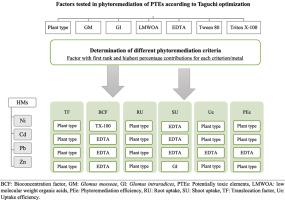Ecotoxicology and Environmental Safety ( IF 6.2 ) Pub Date : 2020-09-15 , DOI: 10.1016/j.ecoenv.2020.111315 B Razmi 1 , R Ghasemi-Fasaei 1 , A Ronaghi 1 , R Mostowfizadeh-Ghalamfarsa 2

|
Growing environmental concern regarding multi elements-contaminated soils reveals the necessity of paying more attention to environmentally friendly remediation techniques such as phytoremediation. A large number of factors influences phytoremediation of potentially toxic elements (PTEs) and investigation on a variety of these factors need appropriate statistical approaches such as “Taguchi optimization” which effectively decreases time and cost of experiments. In the present study, based on the Taguchi optimization method, the effects of several biological (plant type and mycorrhizal fungi (AMF)) and chemical (chelating agents, surfactants and organic acids) factors, on the phytoremediation of soils contaminated with zinc (Zn), lead (Pb), cadmium (Cd) and nickel (Ni) were investigated. The goal was to find out the most effective factors as well as the best level for each factor. The values of dry weights in roots and aerial parts of the studied plants were in orders of maize > sorghum > sunflower and sorghum > maize > sunflower, respectively. AMF was the main factor in increasing dry weight of shoots. Inoculation of AMF caused increases in root and shoot uptake of some PTEs.
Results
showed that phytoremediation of PTEs is element-dependent; as Zn showed the highest translocation factor (TF) and bioconcentration factor (BCF) values, while Ni showed the lowest ones and the intermediate values belonged to Pb and Cd. These results show the diverse distribution of elements in plant parts, as Zn and Ni were mostly accumulated in shoot and root, respectively. Although different factors caused impacts on phytoremediation criteria, the role of plant type in the phytoremediation of PTEs was at the first rank. Mean TF of PTEs in sunflower was 6.3 times that of maize. Sunflower showed high TF value for the four elements and translocated most of the PTEs from root to the aerial parts demonstrating phytoextraction as the main mechanism in this plant. Maize and sorghum, however, showed low TF and accumulated most of PTEs in their roots revealing phytostabilization as the main mechanism. In general, it can be concluded that plant type was the most influential factor in the phytoremediation of PTEs followed by EDTA and AMF. Taguchi optimization revealed the appropriateness and significance of different chemical and biological treatments on phytoremediation criteria of different elements.
中文翻译:

利用Taguchi优化技术研究影响多元素污染钙质土壤植物修复的因素。
对受多元素污染的土壤的环境关注与日俱增,表明有必要更加重视环境友好的修复技术,例如植物修复。许多因素影响潜在毒性元素(PTE)的植物修复,对这些因素中的各种因素的研究需要适当的统计方法,例如“田口优化”,以有效减少实验时间和成本。在本研究中,基于田口优化方法,几种生物(植物类型和菌根真菌(AMF))和化学(螯合剂,表面活性剂和有机酸)因素对锌(Zn)污染的土壤的植物修复具有影响。 ),铅(Pb),镉(Cd)和镍(Ni)。目的是找出最有效的因素以及每个因素的最佳水平。被研究植物的根和地上部分的干重值分别为玉米>高粱>向日葵和高粱>玉米>向日葵。AMF是增加枝干重量的主要因素。接种AMF会导致根系和某些PTE的芽吸收增加。
结果
表明PTE的植物修复是依赖于元素的;因为Zn表现出最高的转运因子(TF)和生物富集因子(BCF)值,而Ni表现出最低的转运因子(TF)和生物富集因子(BCF)值,中间值为Pb和Cd。这些结果表明元素在植物部分中的多样性分布,因为Zn和Ni分别主要分布在枝条和根部。尽管不同的因素对植物修复标准产生了影响,但是植物类型在PTE的植物修复中的作用排在第一位。向日葵中PTE的平均TF是玉米的6.3倍。向日葵对这四个元素显示出较高的TF值,并且大多数PTE从根部转移到地上部分,表明植物提取是该植物的主要机制。玉米和高粱,表现出低的TF并在其根部积累了大部分PTE,这表明植物稳定是主要机制。一般而言,可以得出结论,植物类型是PTE植物修复中影响最大的因素,其次是EDTA和AMF。Taguchi优化揭示了不同化学和生物处理对不同元素的植物修复标准的适当性和意义。











































 京公网安备 11010802027423号
京公网安备 11010802027423号